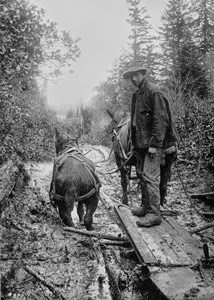This is a continuation of the story of the Spruce Production Division in Lincoln County in 1918. The following oral history excerpts describe the building of the railroad needed to transport the giant Sitka spruce logs. The first step was to clear the right-of-way.
Interviewer: “How was the clearing done for the railroad right-of-way?”
Leonard Groth: “Well, there’d be a cruiser would go ahead, and take out all the underbrush, which was really rough going.”
I: “Take the roots out, too? Or just take it down to the ground?”
LG: “No, no. Take it down to the ground. And then it was shovels from there on. And it really was a job. Gee, it was a job.”
In another oral history interview with Paul Keady, he describes the soldiers making the right-of-way through Waldport.
“And the railroad from South Beach down to Camp 1 north of Yachats was built, mostly with hand labor. Quite a few horses on the job. But as I recall it, no steam shovels, or equipment of that kind. The grade of the hill south of Waldport was almost all built with men with wheelbarrows, digging out the side of the hill, and dumping it over the hill. South of there they had heavy horses, with Fresnos, wheel scrapers, and a four-horse team with a big breaking plow that would plow through that sand of that area, and break it up so the wheel scrapers and Fresnos could move it. That way they filled all these canyons, cut the hills and built the road through. Right through Waldport, past where the school now is, and where the highway now is, the railroad was built up with horses and Fresnos out of the barrow pit. There was a barrow pit all the way through Waldport before they hit hill land on the south side, on each side of the railroad grade...The supplies, when these railroads first started, all came in by water. Then after the railroad was built into Waldport, of course, all the supplies [for the Spruce Division] came by rail.”
This photo shows a crew removing dirt (mud) from a small slide in the right-of-way. A temporary track was laid to allow the use of the cart. This shows some of the conditions these fellows had to deal with in building the railroad.
Back to the interview with Leonard Groth.
I: “And how was the railroad itself built? Was that built by the same people who cleared the right-of-way?
LG: “Yeah, yeah. Same soldiers.”
I: “So first you came in and cleared, and then you built the railroad onto that...”
LG: “Yeah. They’d have their tie crews. They’d have their rail crews. And the rail crews in this book, it shows in there how they used them right on the flatbeds of the railroad cars, the rails...they’d just shove it ahead until they got to the place where they wanted to dump it, and then they’d dump the rail off. Then there’d be--oh, any amount of men you’d want, you know, to pick it up, and put it in place. Then they, of course, had fellows that drove the spikes, and like that.”
LG: “The piling was logged with horses, brought out of the woods. A team of horses. And of course, there’s quite a bit of rain, and there was mud, and that made your pilings skid along pretty good. And that’s the way we got the pilings out.”
These two photos are from Lloyd Palmer’s 1982 book, Steam Towards the Sunset. It is a wonderful account of the railroads of Lincoln County, and contains many photos and a large section on the Spruce Production Division. He also collected historic excerpts from local newspapers in the book that pertain to this topic. Mr. Palmer has done, and continues to do, extensive research on the railroads of this area. [His book is available through the Lincoln County Historical Society Museum Bookstore, and the oral histories are from the LCHS Research Library]. The map is from the LCHS book called, Pacific Spruce Corporation & Subsidiaries, available at the LCHS Museum Bookstore, same link above.
Our previous post, "A Railroad Ran Through It," (click here for link) shows some "then and now" photos and a map of the Spruce Railroad as it went along Beaver Creek.
Posted by jackie.


















No comments:
Post a Comment